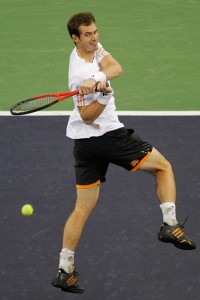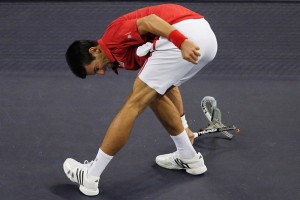Shanghai Masters, Final
(2) Djokovic d. (3) Murray, 5/7 7/6 6/3
‘Let’s use our cameras to capture this moment!’
The manic and skittishly bilingual trophy presentation is always a highlight of the Shanghai Masters 1000, propelled at break-neck pace by an off-camera compere who would, in a different context, qualify as the world’s most tiresome dinner-guest.  He demonstrated how insincerity might sound were it to be weaponised, delivering curiously-nuanced stock-phrases with a velocity and intensity that was exhausting even from afar. Andy Murray, when he was invited to speak – ‘Is this thing on?’ – mostly looked bemused. It was better than he might have looked, given he’d just lost a quite phenomenal final to Novak Djokovic. As two-time defending champion, and with the wreckage of five blown match points and two tennis racquets littering the court around him, he might have looked heartbroken.
He demonstrated how insincerity might sound were it to be weaponised, delivering curiously-nuanced stock-phrases with a velocity and intensity that was exhausting even from afar. Andy Murray, when he was invited to speak – ‘Is this thing on?’ – mostly looked bemused. It was better than he might have looked, given he’d just lost a quite phenomenal final to Novak Djokovic. As two-time defending champion, and with the wreckage of five blown match points and two tennis racquets littering the court around him, he might have looked heartbroken.
Contrary to the fervent hopes of the ATP, high-quality Masters finals were never that common, but in recent seasons they have grown very rare indeed. This year I can only recall Madrid – much maligned Madrid – providing a suitably exciting finale. It was therefore a special treat indeed that Shanghai’s final rose fully to its potential, rather than merely sinking to our expectations. Through its short history, this event has taught us not to expect much. Hopefully that has changed, not merely because of this match, but because of the fine efforts that have shaped the week, especially Tommy Haas’ and Radek Stepanek’s runs to the quarterfinals. Honestly, though, this match is the one destined to endure in the memory.
The final commenced at a pace sufficiently cracking to impress even the evening’s compere, and at a standard sufficient to leave everyone else breathless, except for the crowd, who were merely rendered voiceless from screaming themselves hoarse. It has suddenly become fashionable to talk up the ‘rivalry’ between Djokovic and Murray, but until now I’d remained sceptical that it would amount to all that much, no matter how often they run afoul of each other in the years to come. Before last year they hadn’t played each other very much at all, thanks largely to the perennial third and fourth seedings which saw them marooned in opposite sides of every draw. This year they’ve played each other quite a lot, but most of the matches came to little. The Australian Open semifinal was a fine encounter. But I submit that I’m not alone in believing that the US Open final was, for all its high drama and epoch-fracturing significance, not a particularly great match, owing in no small part to the weather, which was deplorable. Today in Shanghai the standard was much, much higher. The conditions were perfect, but beyond that it was a question of intent.
My main reservation with this match-up is that both Djokovic and Murray are inherently defensive. When neither is willing to attack the points can grow astonishingly long, but only very occasionally interesting, and usually then only in the last few strokes. Tonight it was mentioned, with a misplaced tone of wonder, that the US Open final had featured over 90 rallies of ten strokes or more, as though that was an intrinsically fabulous thing.  I remember the match pretty well, and I vaguely remember the 75th ten-stroke rally feeling wearily similar to the 65th, and wishing that they’d just get on with it. The problem is that one of them must lead, or it merely becomes a battle of the legs, played out over an eternity. There’s always going to be a problem when two immovable objects collide.
I remember the match pretty well, and I vaguely remember the 75th ten-stroke rally feeling wearily similar to the 65th, and wishing that they’d just get on with it. The problem is that one of them must lead, or it merely becomes a battle of the legs, played out over an eternity. There’s always going to be a problem when two immovable objects collide.
Tomas Berdych had discovered just how immovable Djokovic was in the semifinal yesterday: ‘I like to play quite aggressive, and makes the others run. But this doesn’t hurt him that much.’ Meanwhile Murray had faced down a pair of attacking seniors in Radek Stepanek and Roger Federer, and thus had similar incentive to hone his defensive skills to a fine point. But the shift came in his semifinal against Federer, when Murray emerged determined to match the world No.1’s aggression. Especially on return, he was fearsome. Indeed, from the end of the first set there was almost nowhere for Federer to place a second serve that wouldn’t see it belted dismissively away into a corner. This turned out to be an ongoing concern for a guy like Federer who normally defends his second delivery so well, and who’d already broken himself with an anxious trio of double faults. Kickers, sliders, body-serves – they were all dealt with.
Murray began today’s final similarly inclined, but if there’s one thing Djokovic does well – there are in truth dozens of things he does well – it is to lift his intensity when pressed. The result, almost immediately, was that holding serve became nearly impossible for either man, and that the rallies were conducted at a phenomenal pace. The first set was composed of endless highlights, one of which was Djokovic taking some time to extravagantly destroy his racquet upon pushing a volley wide to be broken for 5/6, giving it four lusty blows on the surface and creatively incorporating a half-pirouette. He is a great mover. The rest of the highlights involved tennis. Murray served it out for 7/5.
Relentless breaks gave way to a tightening pattern of holds in the second set, which only served to ratchet up the tension to the point where several crowd members exploded and had to be removed by emergency services. Murray broke through in the seventh game for 4/3. Soon after that he stepped up to serve for his third successive Shanghai title. He moved to 30-0, quickly by the standards of the day. Robbie Koenig insisted on air and on Twitter that the next point was the one upon which the final truly hinged, a scrambling and urgent all-court skirmish that Djokovic finally took with a tweener and drop shot. ‘Oh, stop it!‘ he blurted once it was over.  But I’m not entirely convinced that the match turned there, since that merely brought it to 30-15 in Murray’s favour, and the Scot achieved his first championship point soon after.
But I’m not entirely convinced that the match turned there, since that merely brought it to 30-15 in Murray’s favour, and the Scot achieved his first championship point soon after.
I can concede that the Djokovic that raised his fist and smiled after that point was a dangerously familiar sight, however. It was the reckless and complicated gallows smile he saves for when he has almost given up on winning, and begins to play like there’s nothing left to do but have fun. It was the smile of last year’s US Open semifinal, and this year’s Roland Garros quarterfinal. But it’s not as though the Serb galloped away with the match from there. He saved a match point in that game before eventually breaking back. The subsequent tiebreaker was a minor classic within the larger one, and more crowd-members succumbed. Another four match points came and went, and a clutch of set points. Eventually Djokovic took it 13-11 on a forehand drive volley. Murray’s racquet was also removed by emergency serves, but proved on diagnose to be inoperable.
As it progressed, the final set became a question of movement, in particular of Murray’s movement. At the best of times he relishes nothing more than groping awkwardly and constantly at his thighs – I expect he does it in his sleep, though I lack the means to confirm it – but now he appeared to have reasonable cause. He hobbled during points rather than merely after them, and his second serve lost its bite. It would be vague rather than inaccurate to say that Djokovic sensed this. He certainly saw it, and began to press on his returns, finding outright winners that Murray merely stumbled towards, if that. As had happened all day, the break came in the seventh game, and it seemed clear that it was decisive. Murray was now obviously shortening the points, which was the right thing to do in the circumstances. He just wasn’t winning enough of them. Boldness saved a couple of match points, but not a third. Murray’s final backhand landed long and Djokovic had won his third Masters title for 2012.
Afterwards both men endured a procession of hastily-named dignitaries and hastily-bestowed gifts, which included the trophies and a new Rolex for Djokovic. All of this took up about two minutes, narrated in double-quick Mandarin and unctuous English. After that Djokovic and Murray were commanded in no uncertain terms to pose for photos, no wait, move slightly, more photos. Only when every last camera in the Qizhong Forest Sports City Arena had captured the moment were the players invited to speak. They did, but sounded comparatively diffident, and had little to add. And like that the Shanghai Masters and the Asian Swing was over for another year.

2 Responses to Weaponised Insincerity